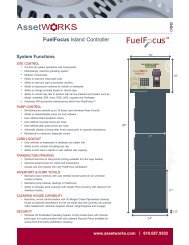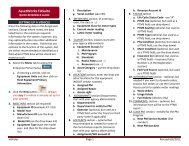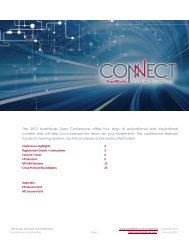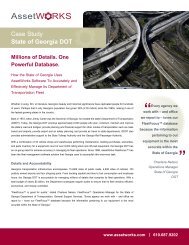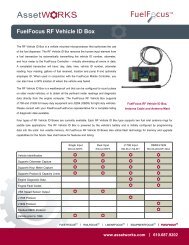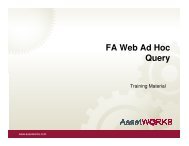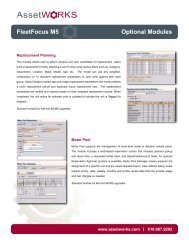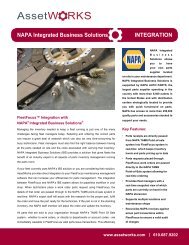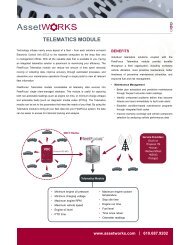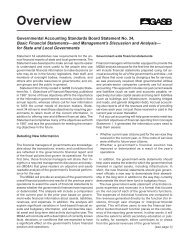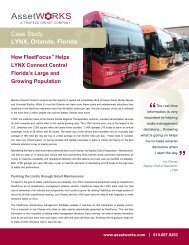The Value Proposition of IWMS - AssetWorks
The Value Proposition of IWMS - AssetWorks
The Value Proposition of IWMS - AssetWorks
You also want an ePaper? Increase the reach of your titles
YUMPU automatically turns print PDFs into web optimized ePapers that Google loves.
(leased/owned) real estate budget <strong>of</strong> $93.7 million or a 15% reduction.<br />
When evaluating a client for potential real estate savings I will use a<br />
conservative estimate <strong>of</strong> 3% to 7% <strong>of</strong> the combined real estate spend.<br />
Expense<br />
Real Estate (program space)<br />
Energy (consumption)<br />
Investment<br />
Maintenance (operations)<br />
Capital (construction)<br />
Energy: Through the continuous retro-commissioning <strong>of</strong> HVAC systems,<br />
the state was able to realize energy consumption (Kwh/mmbtu) savings<br />
<strong>of</strong> 16%-28% per site. <strong>The</strong> dollars associated with energy savings were<br />
$3.0 million, 16% <strong>of</strong> the $18.75 million energy spend. When evaluating<br />
the potential energy cost reduction for a client, I utilize 15% <strong>of</strong> the past<br />
12 month’s energy expenditures as an estimate.<br />
Maintenance: <strong>The</strong> state budgeted $1.68 per square foot for<br />
maintenance. This included all labor and fringe benefits, supplies,<br />
service contracts and small construction projects under $25,000. <strong>The</strong><br />
maintenance budget for the 16.3 million square foot <strong>of</strong> facilities was<br />
$27.4 million. Savings from utilizing a Computerized Maintenance<br />
Management System (CMMS) was $1.6 million per year in reduced<br />
inventory (supply chain management), telecommunications<br />
expenditures (utilizing web based communication vs. DLS lines) and<br />
traditional maintenance labor that was reallocated to the newly created<br />
energy management <strong>of</strong>fice (7 FTE). All these savings were reinvested in<br />
the maintenance program. When evaluating the savings potential for a<br />
client I estimate a 5% savings that will be reinvested in the maintenance<br />
program when deploying a CMMS.<br />
Capital: <strong>The</strong> 10-year statewide capital plan I established was to reduce<br />
the Facility Condition Index (FCI) from 15.5% to 5%. (FCI is the deferred<br />
maintenance backlog divided by the replacement value <strong>of</strong> the portfolio.)<br />
By combining a reduction in the deferred maintenance backlog with an<br />
increase the replacement value <strong>of</strong> the FCI will be reduced. Reducing the<br />
deferred maintenance backlog is a direct result <strong>of</strong> maintaining a<br />
disciplined spending plan. However, an indirect way <strong>of</strong> improving the<br />
FCI is to extend the lifecycle <strong>of</strong> building systems. One can estimate the<br />
value associated with extending the life cycle (continuous retro<br />
commissioning, keeping the existing HVAC systems at or near design<br />
intent) <strong>of</strong> the HAVC systems (20% <strong>of</strong> the replace value) times one tenth<br />
<strong>of</strong> the annual reduction <strong>of</strong> FCI (.001). For the state, the increase in CRV<br />
associated with the ESM was $440,000 per year. When estimating this<br />
value for a client utilize the replacement value if known, or estimate it<br />
at a conservative $135 per square foot times 5% (HVAC system value)<br />
times a planned FCI reduction <strong>of</strong> 1%. <strong>The</strong>se figures can be adjusted<br />
based on the client input and facility type.<br />
WHITE PAPER: THE VALUE PROPOSITION OF <strong>IWMS</strong> 6



